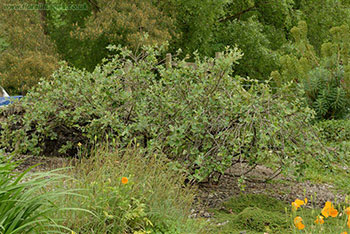Wild Cotoneaster (Cotoneaster cambricus)
 Wild Cotoneaster (Cotoneaster cambricus) is also known as the Great Orme Berry or Creigafal y Gogarth. It has attractive grey-green oval leaves that are woolly beneath and measure 15-40mm. Pink-white flowers around 3mm in diameter appear from April to June in clusters of 2-4. The berries are small (5-8mm across) and bright orange-red in colour, resembling a miniature apple. The Great Orme is the only known locality for this plant in the UK where it grows on isolated and exposed cliff ledges.
Wild Cotoneaster (Cotoneaster cambricus) is also known as the Great Orme Berry or Creigafal y Gogarth. It has attractive grey-green oval leaves that are woolly beneath and measure 15-40mm. Pink-white flowers around 3mm in diameter appear from April to June in clusters of 2-4. The berries are small (5-8mm across) and bright orange-red in colour, resembling a miniature apple. The Great Orme is the only known locality for this plant in the UK where it grows on isolated and exposed cliff ledges.
It was originally thought that this plant may be Cotoneaster Integerrimus, which may have been introduced to the UK. However recent genetic evidence from Royal Botanic Gardens, Kew has shown it to be a native species in its own right, Cotoneaster cambricus. When the plant was first recorded in the eighteenth century, it was described as being widely distributed at the locality but by 1978 it had declined to six individuals. Today the population has since been supplemented by the introduction of new plants grown in cultivation.
As well as being listed as a species in the Conwy Local Biodiversity Action Plan Cotoneaster cambricus is also designated as a UK Biodiversity Action Plan species – highlighting the need for action to conserve this species.
Wild Cotoneaster plants have been sent to Kew, Ness and Treborth Botanic Garden to maintain specimens of the plant outside of the Great Orme. Our specimens are located on the top limestone end of the rock garden where is grows in free-draining, calcareous substrate.
Find out more about Cotoneaster cambricus Species Action Plan.
Newsletter
Conservation propagation of Cotoneaster cambricus
Conservation propagation – a legacy project
